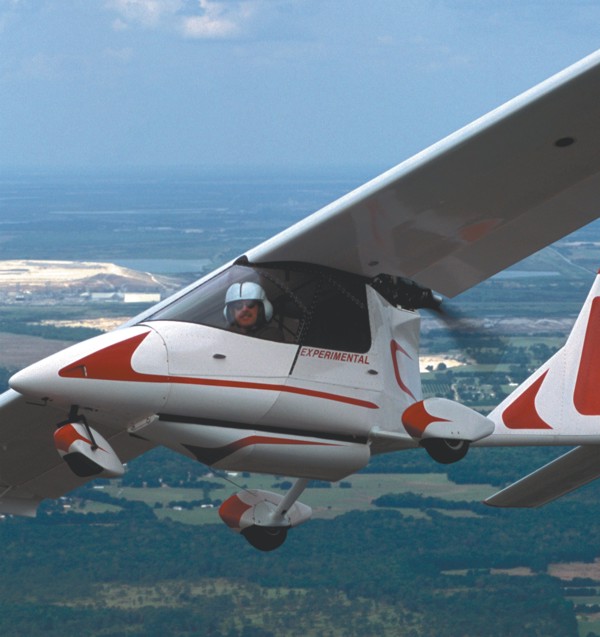
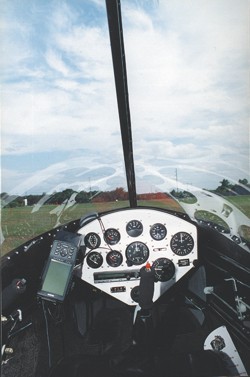
PANEL GLARE – While you have oodles of visibility from a Tornado, the use of a white panel causes reflection on the windscreen. Fortunately, I didn’t notice it too much while flying.

NEAT LAYOUT – Roger Bacon did a quality job of using his panel space to accommodate a range of instruments in his Tornado 912. I especially like his coordination ball installation (arrow).
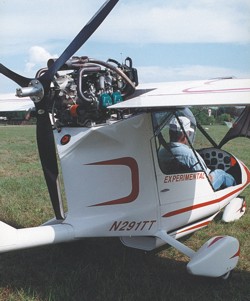
ROTAX 912 – Fitted with a green valve cover Rotax 912S, Roger Bacon’s Tornado has 100 hp at its disposal, enough for lively departures from terra firma and a 1,800-fpm climb rate.

TIME TO SWITCH – For his many optimal features, Roger Bacon added this switch panel on the right side of the cockpit. That’s the rear right rudder pedal just below the switch panel.
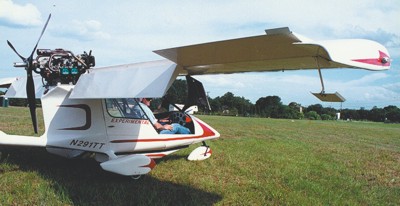
BIG DEFLECTION – Note the way-down position of the Tornado’s flaps while Roger Bacon deflects the ailerons for a right turn. He has fine-tuned the control surface with spades that bring very light roll inputs.
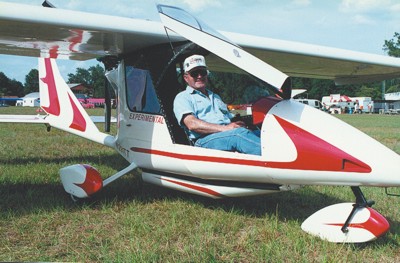
READY, SET, GO – Owner Roger Bacon flashes a smile before buttoning up his Tornado and heading for takeoff. The optional luggage pod offers little surface area to produce drag.

SHORT & LONGER – The Tornado II 912, like the rest of Titan’s line, uses a short wing span that works very hard. What’s different is the 8-foot-wide horizontal stabilator that helps with the powerful engine. That’s a foot wider than the standard Tornado.
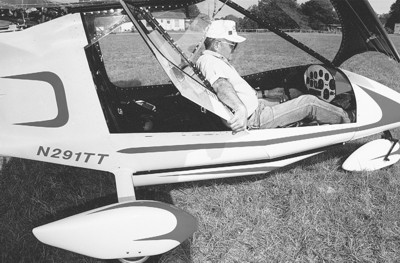
SEATING OR CARGO – While seated in the front, Roger Bacon holds open the rear entry door in an invitation to place cargo or an occupant inside.
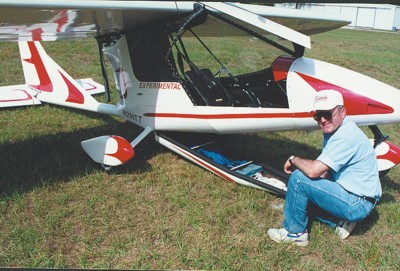
LUGGAGE POD – One of Titan’s many options is this luggage pod that fits neatly under the fuselage and hinges at the rear. Since space is at a premium inside a Tornado, here’s a way to carry things you’ll need at your destination.
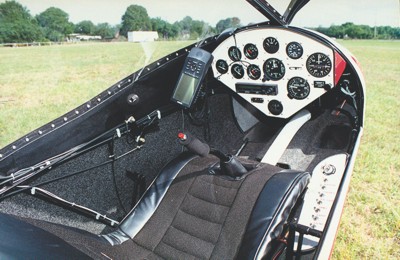
JOCK SEAT – This cockpit arrangement gives the impression of a fighter cockpit among ultralight aircraft, a fact that interests many buyers of the sleek design.
Over the years, Titan Aircraft has made their Tornado a familiar aircraft seen at flight parks and airports around the nation. Since it was introduced in ’91, the sleek, efficient plane has evolved into a variety of models.
This month we examine the fine work of Roger Bacon who created a lovely red-and-white Tornado II 912, powered by the 100-hp Rotax 912S 4-stroke powerplant expected to be commonplace on light-sport aircraft. Bacon’s airplane is licensed in the Amateur-built category but its facts and figures suggest it could be flown with FAA’s proposed Sport Pilot certificate (until FAA’s new rule is introduced, a private pilot’s certificate or better is required).
Usually I prefer to fly a factory airplane to make sure it correctly represents what a buyer might receive. However, Bacon’s model is so well done, Titan Aircraft encouraged a test flight. Thanks to Bacon for his willingness to let me take his pride and joy aloft.
Popular Design
Even with the potent Rotax 912S and all its related hardware plus controllable-pitch prop, Bacon estimates his Tornado has a 647-pound empty weight including the empty cargo pod. From the plane’s 1,000-pound gross weight that leaves a 353-pound useful load. Fuel at 14 gallons leaves 269 pounds of occupant and luggage. A pretty lean Bacon could carry a lightweight occupant or virtually all the baggage he cared to bring along.
It was a warm Florida day when I flew his machine, which highlighted one drawback of a fully enclosed model like the Tornado 912. Good fresh-air inlets are important as you sit in a greenhouse-like Lexan cockpit. Bacon admits he put the air inlet a little too far aft. Moving them slightly forward would improve their operation, he says. I had to put my right hand down near the NACA inlets to direct more air at me. Fortunately this wasn’t Florida’s hottest day or the air shortage could have been uncomfortable. However, despite the warmth inside the Tornado, I had to admire the detail that went into this particular model.
Titan Aircraft designed the Tornado II 912 to a +6g/-4g limit load capability at 1,000 pounds gross weight. Such strength – representing a higher ultimate load limit than most factory-built general aviation aircraft – combined with the Tornado’s superb handling made for an inspiring flying machine. No wonder Titan has enjoyed great sales of this line of aircraft.
After a review of Bacon’s numerous, very clearly labeled controls and interior, I entered the pilot-in-command seat of his Tornado. Front seat entry is easier than the rear as the door allows more room to bring your legs and feet inside.
Like many other pilots, I’ve always been attracted to the Tornado cockpit. The laid-back, curvaceous seat with the control stick emerging through an opening is fetching. Besides the fighter pilot styling of the plane, Bacon had his interior finished off with sound-deadening material. A large panel presented all the instruments you need in a light plane. However, this introduced one of my few criticisms of this Tornado.
With the light entering the cabin from certain directions the white face of the instrument panel reflected significantly in the windscreen. A black panel, though more commonplace and therefore less striking visually would reduce reflection and suit me better.
The way the panel narrows at the bottom allows sufficient room for your legs though no Tornado will give you much room to move your legs around in flight. This is even less so in the rear.
Cabin Controls
The Tornado’s cabin may be on the snug side for some larger pilots, but more so than most other ultralights, it imparts a gutsy, go-get-’em feel. Almost everyone loves the sensation. Controls are generally close at hand though some have to be unusually placed.
Perhaps in an effort to economize interior room, Bacon’s throttle had a very short throw, such that when adding power the action is almost sudden. Applying fine control will take practice. The choke lever, located right below the throttle, also has a very short arm. And where Bacon mounted his GPS, it tended to bump against my knee.
A trim wheel is located below your left thigh under the seat. The outside of the trim wheel is your guide to its rather nonintuitive operation. My mantra became: outside of the wheel up for nose-up, and outside of the wheel down for nose-down. Any memory jogger that works for you will suffice, but you need a system, as the wheel is different than most trim controls.
The prop control switch, located right above the trim wheel, is up for more prop rpm and down for less prop rpm. Though you can’t see this switch while flying, its movement is intuitive.
Taxiing out for takeoff, I experimented with the Tornado 912 before committing aviation. I found Bacon’s toe brakes to be a little difficult to find at first and not particularly effective. Most aviation brakes lack the power we’re used to in autos, but neither are they as vital for normal operations.
The Tornado’s suspension, or lack thereof, made for a fairly rough ride on South Lakeland Airpark’s turf runway, suggesting this particular aircraft may be better suited to hard-surface runways.
Finally positioned on the runway, I gently opened the throttle on Bacon’s Tornado II 912. I’ve experienced 912 takeoffs before on light aircraft and find that full power is rarely needed. Most pilots find an excess of power to be valuable but 100 horses for 1,000 pounds seems overkill in my mind.
However, by applying the throttle smoothly and steadily, takeoff came without incident and certainly delivered a sensation of power. In no time Bacon’s Tornado was dashing down the runway and ready for rotation.
When you approach for landing in the Tornado, you can be glad of two things. First, this is one hard-working wing that produces an uncommon amount of lift for its relatively short 23.5-foot span. The wing design derived from Mark Beierle’s Thunder Gull and it remains one of the finest-engineered wings I’ve experienced in flying many light aircraft.
Aiding the efficient wing are large flaps that deflect downward to a sharp angle (about 40°). These two design features combine to take the speedy Tornado down to genuine ultralight approach speeds. In my mind, the go-fast, then go-quite-slow capability of the Tornado line may be one of its best attributes. In aviation, the “Holy Grail” of design aims at a 4:1 ratio of fastest cruise to slowest stall. Titan Aircraft has achieved a range in the Tornado 912 that runs from a 120-mph cruise to a 35-mph stall (with best flaps), putting the design very close to the magic ratio.
Aerodynamic Controls
Fortunately for Titan Aircraft and those who buy their aircraft, the speed range is only one of several good virtues of the design. The Tornado also exhibits some of the best handling qualities to be found in light aviation.
Tornado rudder pedals are quite powerful. Only a little movement was needed to move the control noticeably. Since your legs are stronger than your arms, this small-movement-for-good-response characteristic doesn’t spoil the feeling of good control harmony.
My Dutch roll coordination exercises went quite well to quite steep bank angles, no doubt partly thanks to this aircraft being equipped with spades. These aerodynamic surfaces lighten control feel by accentuating the input of the pilot. Some engineers say spades are not necessary and hanging them out in the wind at the end of the wing is not graceful design work. But having flown several Tornadoes with and without spades, I’m willing to state I prefer them on this aircraft.
Do you wonder how spades work? Here’s a brief explanation: Spades are shovel-shaped surfaces, rigidly mounted on arms forward of the ailerons. They provide aerodynamic balance and reduce the effort needed to roll the airplane. When the ailerons are neutral, the spades are aligned with the airstream and do nothing. But when an aileron is deflected upward, for example, its spade tips downward. Air pressures on the spade help the aileron do its job. Think of a small person on one end of a teeter-totter who helps a larger person at the other end push off the ground. The farther the aileron is deflected, the larger the force supplied by the spade. Aerobatic pilots describe spades as bringing a feel like power steering on a car.
The Tornado is efficient enough that rudder pressures were light and it seemed best to lead with the ailerons when making reversing maneuvers.
Once in a turn, the Tornado continued the turn, almost on its own. Very little input was required to maintain a set bank angle. During roll entry and exit my lack of familiarity with this particular aircraft caused me to not keep the ball centered. This is not uncommon on aircraft with light, responsive controls yet most pilots will adapt quickly enough.
A lot of P-factor is at work on Bacon’s Tornado, no doubt attributable to both the potent engine and a prop that can bite a lot of air depending on where it is set. I could advance the throttle and move the prop to high rpm and watch the ball leave its coordinated place in the center of the tube.
During most of my flight in this Tornado, it seemed I needed to keep the nose a little higher than I naturally wanted to, the opposite of many ultralights I’ve flown. This may be explained by the wide-open view over the tapering nose.
The “Hoo-Yah” Factor
Nobody flies a light aircraft with a 100-hp Rotax 912 and comes away with a ho-hum response. The combination easily creates a level of excitement about its overall performance. Add a controllable prop to the mix and you have some serious enthusiasm being generated.
My interaction with Bacon’s electric prop was better than a similar experience in the Sky Ranger. On that French design, I didn’t operate it correctly mostly due to lack of any indicator saying where it was set. I put the prop into a too-coarse setting with the power reduced and the engine felt sluggish. All constant-speed general aviation props have instruments that help you set the prop precisely. Such would be valuable in light aviation as well, but once owners get enough time with the system, they hardly need a gauge to tell them where the prop is set.
I found the comfortable cruising speed proved to be about 90 mph indicated, or perhaps even a bit more. However, this Tornado could clearly run much faster. At about 4,500 rpm with the prop properly pitched I recorded about 105- to 110-mph cruise. At full boost, it can exceed 120 mph. Conversely, at 5,500 rpm with the prop pitched high and holding 75 to 80 mph I was able to keep the vertical speed indicator (VSI) climb pegged at an impressive 2,000 fpm.
At near idle thrust, and about 60 mph with no flaps, the descent rate hit 1,000 fpm. With just a little power and the same speed, the descent rate dropped to a more modest 500 fpm. However, in an engine-out situation, the descent rate appears to be rather high. Given the small wing area, this is hardly surprising even if the wing design works hard to produce lift.
Bacon reports his Tornado carries 14 gallons of fuel. At a high 120-mph cruise speed, he says his Rotax 912S has a 2-hour duration with generous reserve. Therefore it can cover 250 miles before refueling. I’m confident that if you backed off to 95 to 100 mph, your endurance would jump significantly.
On the Tornado 912, the stabilator has an 8-foot span versus the 7-foot span used with smaller engine installations. Longitudinal stability was good and the wider span surely helped. I didn’t disturb the controls aggressively but in all checks I made, the Tornado returned to level flight rapidly. However, extra power added energetically does push the nose over, as you’d expect from a design with high thrust line.
Adverse yaw on this Tornado was interesting. It did not immediately tend to go in the right direction but neither did it try to go the opposite direction. It merely hesitated for a moment and then moved the proper way.
Buying a Whirlwind
The airframe kit for the Tornado is $13,500. Add the Rotax 912S engine ($12,990) to that and you’ll just about double your investment. You could also choose the 80-hp Jabiru 2200 engine and save $3,000 for 20 horses less, making it a better price deal than the 81-hp Rotax 912 at $11,770.
However, that’s just the beginning. Titan Aircraft offers a long list of options that will help you get rid of your tax refund. For example, Bacon’s luggage pod adds $890 and if you want the 150-mph “Vne package,” you’ll add $500 to the price of the 912 or “S” model kits (see sidebar, “Titan’s New ‘S’ Model Tornado”). Hydraulic brakes will add $723 and you need to scan the list on their literature or Website for more choices.
Beyond accessories, you may wish to explore a good list of building options. For example, you can choose prebuilt wings for $2,800 or the Fast Build option for $5,900. Crating of whatever kit you buy will also add a few dollars.
I didn’t ask Bacon what he invested, but based on the information above, he’s got well over $30,000 in his Tornado 912.
Titan Aircraft estimates build time for a standard Tornado at 150 to 300 hours. All required materials, components, and fasteners are included in the airframe kit. Not included in the basic kit are engine, propeller, and instruments because of different customer preferences.
The company’s quick-build option is popular among pilots who’d rather fly than build. Titan says the Tornado Fast Build Kit “includes a completed wing; the control surfaces and wing tips are built, but not installed. The fuselage has the aluminum skins, controls, tail assembly, landing gear, and brakes installed. It does not include installation of engine, fabric, instrument panel, windows, doors, fiberglass parts, interior, or finish work.”
Naturally, if you deck out your Tornado as elegantly as Roger Bacon did, you’ll have more time
and money into it, but whatever you pay and however long it takes to build, my guess is you’d enjoy flying your Tornado as much as I enjoyed Roger’s.
| Seating | 2, tandem |
| Empty weight | 540 pounds 1 |
| Gross weight | 1000 pounds |
| Wingspan | 23 feet, 6 inches |
| Wing area | 108 square feet |
| Wing loading | 9.3 pounds/square foot |
| Length | 19 feet |
| Cabin Interior | 28.5 inches |
| Height | 6 feet 6 inches |
| Kit type | Construction Kit |
| Build time | 300-400 hours |
| Notes: | 1 Empty weight does not include options like the luggage pod; as tested, empty weight reported as 647 pounds by owner. |
| Standard engine | Rotax 912 |
| Power | 80 or 100 hp |
| Power loading | 10 pounds per hp |
| Cruise speed | 120 mph |
| Never exceed speed | 150 mph |
| Rate of climb at gross | 1800 fpm |
| Takeoff distance at gross | 300 feet |
| Landing distance at gross | 250 feet |
| Standard Features | Rotax 912 with electric starting, aluminum cantilevered wing, aluminum fuselage with fiberglass nose and wheel pants, fully enclosed, two right-side doors, stabilator with in-flight trim, brakes, composite landing gear, rear cargo door, lap and shoulder seat belts, 15-gallon fuel tank. |
| Options | 80- or 100-hp engine, wheel pants, streamlined gear legs, ballistic parachute, floats, instruments, hydraulic brakes, strobe lights, starter kit, quick-build kit. |
| Construction | Aluminum wings, fuselage and tail, welded steel structure, fiberglass nose pod and wheel fairings, composite landing gear, Lexan. Made in the USA by an American-owned company; distributed by U.S.-owned company. |
Design
Cosmetic appearance, structural integrity, achievement of design goals, effectiveness of aerodynamics, ergonomics.
Pros – A Tornado with a 100-hp Rotax 912S is a potent light plane with a fighter pilot look and feel. Long-lasting, all-metal wing is notable for its efficiency (nearly 4:1 speed range). Titan has evolved this popular design into several models, including new “S” version. Good comfort, control access, and visibility.
Cons – Snug interior for larger pilots/occupants (but see sidebar). Built with Rotax 912S engine and many accessories, payload decreases. Build time greater than bolt-together kits and metal material is not familiar to many builders (though Fast Build Kit eases the building effort notably).
Systems
Subsystems available to pilot such as: Flaps; Fuel sources; Electric start; In-air restart; Brakes; Engine controls; Navigations; Radio; (items covered may be optional).
Pros – The Tornado II 912 can have many features (as either Amateur-Built aircraft or proposed light-sport aircraft): trim, flaps, adjustable rudder pedals, controllable pitch prop and more. Trim worked effectively with good control ratio. Good engine inspection/repair access. Fueling done from outside the aircraft (though tank inside).
Cons – Trim adjustment is nonintuitive requiring you learn its operation; also located under the seat where access is more challenging. Many systems available means higher learning curve for a new pilot. Little space for navigation aids like GPS unit.
Cockpit/Cabin
Instrumentation; Ergonomics of controls; Creature comforts; (items covered may be optional).
Pros – Excellent visibility with pilot in front of wing; especially good field of view for a full enclosure. Seats offered excellent lower leg support; most pilots will love the control stick opening. Front door allows entry quite easily. Carpeted interior inviting and suppressed noise. Four-point seatbelts were appreciated.
Cons – You’ll want to make sure air vents bring in enough air in warm climates; greenhouse effect is noticeable. Somewhat on the noisy side (though no worse than many others). Rear-seat visibility is hampered by structure. Rear seat entry/exit is difficult unless you select the longer “S” model.
Ground Handling
Taxi visibility; Steering; Turn radius; Shock absorption; Stance/Stability; Braking.
Pros – Visibility is very good for pretakeoff traffic checks. Steering precision was good and the differential brakes were helpful and effective. Turn radius is very small. Steering control feedback was good. Ground stability appears excellent.
Cons – Shock absorption was quite firm, transmitted to your body directly; the Tornado seems better suited to hard-surface runways than bumpy turf. Loaded rather lightly on nosewheel; may affect steering. Ground clearance is somewhat limited in this low-slung design.
Takeoff/Landing
Qualities; Efficiency; Ease; Comparative values.
Pros – Landing visibility is outstanding; takeoff visibility is better than average in spite of steep climb angle potential with Rotax 912S. Wings and flaps work hard to provide low approach speed, surprisingly so considering the short wing. Good control authority aids crosswind landings.
Cons – Descent rate with no power or flaps was rather high; recommend flaps for all landings. Ground roll somewhat longer if loaded to full gross. Assure controllable-pitch prop in correct position before starting approach. Landing in rough fields could be a problem due to modest ground clearance.
Control
Quality and quantity for: Coordination; Authority; Pressures; Response; and Coupling.
Pros – Tornado controls are responsive in all axes. Precision turns to headings are very straightforward. Control authority is strong for maneuverability and ease of operation in crosswind conditions. Rudder power was excellent and predictable. Steep turns revealed the wing’s efficiency.
Cons – With spades (as flown), the controls may be too light for some pilots. Throttle (also choke) control was a short lever that tended to exaggerate move; fine control will take practice. Rudder pedals had a relatively short throw for a given amount of effect.
Performance
Climb; Glide; Sink; Cruise/stall/max speeds; Endurance; Range; Maneuverability.
Pros – The Tornado hits the magic 4:1 fast-to-slow speed range that many designers strive to achieve. Cruise to 120 mph; economical speed still 90 to 95 mph. Slows well and behaves beautifully even near stall (at 35 to 40 mph). Climb rate is breathtaking at close to 2,000 fpm at max. Short takeoff roll.
Cons – Sink rate is higher than average (though not surprising given the gross weight and short span/square area). Owner states fuel burn as higher than expected. No other negatives in this category.
Stability
Stall recovery and characteristics; Dampening; Spiral stability; Adverse yaw qualities.
Pros – Mild stalls in all regimes, breaking only with aggravation and then only if power off. Power-on stalls simply don’t occur (though deck angle is very steep). Accelerated stall breaks but recovers fast and easily. Longitudinal stability proved very good in all tests. Steep turns again showed wing efficiency.
Cons – Throttle response typical of high-thrust-line designs; backwards of what a general aviation pilot would expect. Adverse yaw must be considered though it, too, is manageable. Found no other negatives.
Overall
Addresses the questions: “Will a buyer get what he/she expects to buy, and did the designer/builder achieve the chosen goal?”
Pros – Inspiring design in many ways combines well with responsive handling. Would-be fighter pilots love Titan designs. All metal (and some fiberglass/Kevlar) aids longevity. Airframe kit is fairly priced and several quicker-build options are available. Titan Aircraft is a respected, long-term member of light aviation community.
Cons – Real big pilots may fit but will be snug inside. Lexan-covered cockpit demands some good air inlets. With Rotax 912S engine and accessories as flown, price will generously exceed $30,000 plus build time. As flown, rear seat will be restricted to very light occupant or luggage.


I need to buy the main landing gear assembly for a Titan Tornado II. I live in Chile.
Hi Javier: You can search for the manufacturer easily on ByDanJohnson.com but here is a link to Titan Aircraft.
Is tail clearance an issue especially in flapless config?
Can tundra tyres be fitted, would they allow additional clearance and better ground handling on grass? Their expected effect on performance?
Please check with Titan Aircraft Engines (see link at the end of the original) to get factory advice for your questions.